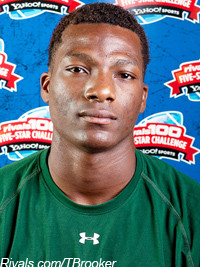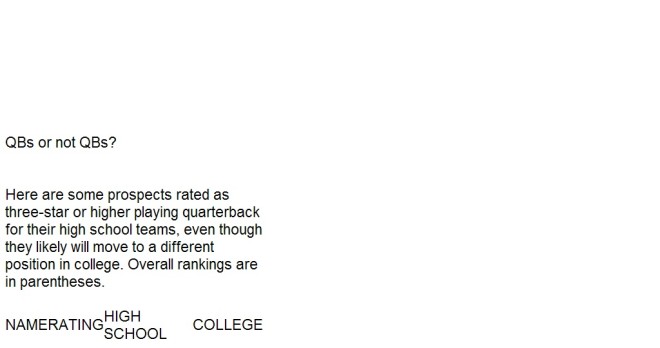QBs might make the transition

Although he heads into his senior season as the nation's top 2013 receiving prospect, Ricky Seals-Jones has spent much of his high school career throwing passes instead of catching them.
Seals-Jones played quarterback last fall at Sealy (Texas) High and will likley have the same job this year. It's a role he reluctantly accepted for the good of his team.
Advertisement
"When they first told me, I was kind of iffy about it," Seals-Jones said. "But I played it in junior high. And to help the team win I'd do it. I had to just change over."
However, Seals-Jones' situation isn't that uncommon. Plenty of other elite prospects also play quarterback for their high school teams, even though they're expected to move to wide receiver or defensive back in college. While their future may lie elsewhere, their status as the best athlete on their high school team puts them at quarterback for now.
"It's just like the point guard of your basketball team," Fort Myers (Fla.) High coach Sam Sirianni Jr. said. "You're going to take your best athlete, I believe, and you mold an offense around him."
That's probably the best thing for their high school teams, but is it the best thing for their development? That question leaves high school coaches facing a delicate balancing act as they try to win games while assuring their top prospects are adequately prepared for the next level.
This dilemma also forces college coaches to take a leap of faith in figuring out how a high school quarterback might fare at a different position, while they remain patient as that player adjusts to his new assignment.
"It just takes them a little bit longer to become dominant football players at specific positions because they're not used to it," Rivals.com national recruiting analyst Mike Farrell said. "They haven't been practicing at it every day. They have to learn the things that take a lot of practice."
The Rivals100 features a number of high school quarterbacks destined to play other positions in college.
LSU commit John Diarse is rated as the No. 11 wide receiver and No. 83 overall prospect in the 2013 class, yet he plays quarterback at Monroe (La.) Neville. Ohio State-bound all-purpose athlete Jalin Marshall -- the nation's No. 48 overall recruit -- also is being recruited primarily as a receiver, even though he plays quarterback at Middletown (Ohio) High.
Jackson (La.) East Feliciana quarterback Kendell Beckwith is rated 81st in the nation and will most likely play linebacker or defensive end in college.
Diarse and Marshall have been playing quarterback all their lives. They realized they eventually would need to switch positions after colleges started recruiting them to play elsewhere. Now, they are both preparing to run their high school offenses while also anticipating the adjustments they'll need to make in college.
"I do a number of different drills to prepare myself for receiver," Diarse said. "I take some drills from camps. I make up some on my own. It comes from all over."
This isn't anything new for LSU, which has made a habit of recruiting athletic high school quarterbacks and moving them elsewhere.
Russell Shepard signed with LSU out of Houston (Texas) Cypress Ridge in 2009 as the nation's No. 1 dual-threat quarterback prospect, but he played a few different positions in college before settling in at wide receiver.
Rueben Randle moved from wide receiver to quarterback his senior year at Bastrop (La.) High, then moved back to receiver at LSU and adapted well enough to get drafted in the second round by the New York Giants this year.
Early Doucet, an LSU receiver from 2004-07 who now plays for the Arizona Cardinals, lined up at quarterback, receiver and running back for St. Martinville (La.) High.

Farrell pointed out that Randle and Shepard needed some time to adjust to their position switches. He believes most high school quarterbacks who switch positions in college will initially endure similar growing pains, even someone as talented and physically gifted as Seals-Jones.
"Ricky Seals-Jones doesn't really know how to run routes," Farrell said. "He knows how to run a slant or a post, but he doesn't know how to sell a comeback route or a dig route or anything like that. That's stuff you're taught in practice when you're a wide receiver.
"Also, he doesn't know how to catch the ball right now. He uses his body first and not his hands. That's not his fault. It's just that it's very difficult for these guys to get reps (at other positions) when they're the quarterback because they've got to focus on that."
But there are other ways in which they benefit.
Seals-Jones admits he would go back to receiver "in a heartbeat" if he could, but he also noted that playing quarterback could help him in the long run. He believes the experience eventually could make him a more complete player.
"It's a lot different," Seals-Jones said. "As a receiver, you just know your route. At quarterback, you have to know every route. That kind of helps you as a receiver."
As one of the nation's most touted receiving prospects, Seals-Jones also gets a chance to work out at his future position at various showcases. He joined Marshall and Diarse in working against some of the nation's elite cornerbacks recently at the Rivals100 Five-Star Challenge.
Players of that caliber don't really have to worry about whether playing quarterback in high school will cause colleges to shy away from them. They also do get plenty of chances in the offseason to prepare for the roles they'll inherit in college.
However, the challenge is a bit trickier for lesser-known prospect in this situation.
Take Fort Myers all-purpose athlete T.J. Douglas, for instance.
"I've always been a quarterback, playing Pop Warner and all that," said Douglas, who has major-conference offers from Boston College, Duke, Iowa State and Purdue.
Yet most of the major-conference teams recruiting this two-star prospect want him to play somewhere else. Duke is recruiting him as a wide receiver. Other schools like him as a safety.
Douglas remains a quarterback at Fort Myers, but Sirianni has taken steps to make sure his player is adequately prepared for his college assignment. He encouraged Douglas to play receiver and defensive back on a local traveling 7-on-7 team.
When college coaches watched Fort Myers practice this spring, Sirianni would use Douglas as a defensive back. He also used Douglas on defense in the spring game and plans to play him on both offense and defense this fall.
Sirianni even made a highlight video of Douglas performing defensive back drills and catching passes.
"It's a little different than the old days when the high school quarterback who was a good athlete was recruited more on potential, that they knew he could be moved to another position," Sirianni said. "Now the process is so much (different) with the ratings and all the things they have to do. I needed to showcase him this spring."
Of course, some colleges remain willing to take a chance on the potential of an all-purpose athlete who happens to play quarterback.
Mississippi State cornerback Johnthan Banks and wide receivers Chad Bumphis and Jameon Lewis all played at least some quarterback for their respective high schools, though Banks and Bumphis also got plenty of work at their current positions.
Mississippi State's 2012 signing class included four-star prospect Will Redmond, a likely college safety who played both quarterback and defensive back at Memphis (Tenn.) East.
Mississippi State coach Dan Mullen dismisses the notion that these types of all-purpose athletes have a longer adjustment period when they get to college.
"Actually, I think a lot of them develop faster because they understand the game from the quarterback position," Mullen said. "Whether they go to play defensive back, go to play running back or go to play receiver, they understand the game from the quarterback's eyes. I think they really have a leg up on seeing the game a different way."
Mullen also considers it a vote of confidence when a high school coach puts an all-purpose athlete at quarterback. After all, high school coaches often like to assign that position to their best overall player. If that prospect also shows he's a winner and displays the ability to play multiple positions, why not give him a look?
"If the high school coach trusts them enough to play quarterback -- and we think they're athletic enough to play somewhere else -- they must be a special guy," Mullen said.
That type of message should encourage Douglas and all the other sleeper all-purpose athletes playing quarterback for their high school teams. Sometimes their versatility can make up for their lack of polish.
Sirianni believes Douglas has the ability to develop into a successful college quarterback in a spread offense. Arkansas State and Florida International have offered him the opportunity to play quarterback.
But at the same time, Sirianni understands that most major-conference schools believe Douglas' 6-foot-1, 185-pound frame make him better suited for wide receiver or safety.
Wherever Douglas ends up, Sirianni believes his quarterback will succeed. While discussing the wide array of skills that have enabled Douglas to get recruited at multiple positions, Sirianni borrows a baseball term by referring to his player as a five-tool prospect.
"T.J ís a five-tool football player," Sirianni said. "He can run. He can throw. He can catch. He's physical. And he's also level-headed."
Douglas may need all those traits to make a successful transition to a new position in college. The same is true of all the other high school quarterbacks destined to play elsewhere at the next level. But that won't prevent some colleges from taking a chance on these types of players.
Maybe they'll need more time to adjust to the college game.
But sometimes the long-term reward makes the short-term cost worthwhile.

Click Here to view this Link.
[rl]